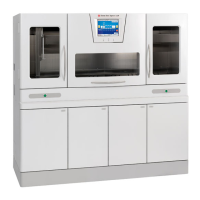Revised 10/02/2012 A.3
Hematoxylin and Eosin (H&E) and Special
Stains:
• Tinctorial staining is slightly more intense with
Molecular Fixative than with Formalin-fixed tissues.
• Tissue may stain more eosinophilic when using
Tissue-Tek Molecular Fixative, which may require
decreasing the staining time in Eosin (approximately
40%).
• Molecular-fixed tissue and Formalin-fixed tissue
yields similar staining results for special stains.
Immunohistochemistry:
• Some types of Molecular-fixed tissue may not require
Antigen Retrieval.
• Molecular Fixative does not cause cross-linking,
which occurs with Formalin.
• Increased intensity of IHC staining can be anticipated
with some types of antibodies when tissue is placed
directly into Molecular Fixative.
• Tissue for Her-2 must be
fixed in Formalin to comply
with FDA approved protocols. Refer to the manufac-
turer’s operating protocol for specific instructions on
how to fix the specimens.
RNA:
• Molecular fixative preserves RNA from degradation, if
tissue is placed directly into the solution immediately
upon surgical excision.
• Finer nuclear detail can be expected with the use of
Molecular Fixative.
• Molecular fixed tissues yield amplification curves
similar to fresh specimens.
Do not
process tissue for RNA studies in Formalin or
expose tissue for RNA studies to any items that have
come in contact with Formalin. RNase-free conditions of
paraffin embedded tissue will yield intact RNA comparable
to fresh tissue. If the Tissue-Tek Xpress x120 has been
used for processing Formalin-fixed tissue, the Tissue-Tek
Xpress x120 must be cleaned prior to use for RNA study
(see “Cleaning Instructions for RNA Tissue Processing” on
page A.3 for details).
DNA:
• Tissue treated with Molecular Fixative yields similar
results to enzyme digested DNA extracted from fresh
tissue (frozen).
• Crossing Threshold for Molecular-fixed tissue is
comparable to DNA extracted from fresh tissue.
• Crossing Threshold measured after 24 hours yields
results similar to DNA from fresh tissue.
PROTEIN:
• Molecular fixed tissue yields gel electrophoresis
results similar to those seen from protein extracts
from fresh tissue.
• Western Blot testing shows stronger distinct bands
when compared with Formalin-fixed material.
• Time interval between surgical excision and tissue
fixation in Molecular Fixative (usually 30 minutes),
does not affect the quality of the extracted proteins.
Cleaning Instructions for RNA Tissue
Processing
Description:
Processing of RNA tissue requires an RNase-free
environment. If the Tissue-Tek Xpress x120 has been
used for processing Formalin-fixed tissue, the Tissue-Tek
Xpress x120 must be cleaned prior to use for RNA study.
Failure to properly prepare the Tissue-Tek Xpress x120
prior to processing tissue specimens for RNA studies may
cause the degradation of RNA.
Materials and Equipment Required:
• 0.1% diethylpyrocarbonate
• Sterile water
• Autoclave
• RNaseZap
®
Wipes (may be purchased from Ambion,
Inc, TX, USA www.ambion.com)*
• Gloves
• Face mask
* RnaseZap
®
is a registered trademark of Ambionm Inc.

